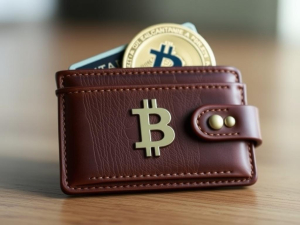
Many new users make critical mistakes when choosing a crypto wallet. One of the most common errors is selecting a wallet based solely on popularity or recommendations without understanding its specific features and security measures. A wallet that is popular among peers may not necessarily fit an individual’s needs, especially regarding asset compatibility and transaction fees.
Another frequent issue arises from neglecting to consider security protocols. Many users overlook the importance of two-factor authentication (2FA) or hardware wallets, opting instead for less secure online solutions. This oversight can lead to significant losses due to hacking incidents. It’s advisable to prioritize wallets that implement robust security practices to protect assets effectively.
Additionally, new users often fail to evaluate backup options adequately. Not having a recovery phrase or proper backup can result in irreversible loss of access to funds. Always ensure that any chosen wallet provides clear instructions for backing up your data securely.
The lack of research into customer support can also be detrimental. Some wallets offer minimal assistance, leaving users stranded during critical situations. Before committing to a wallet, reviewing user feedback and support availability can help avoid future inconveniences.
Lastly, many individuals underestimate the significance of transaction fees associated with different wallets. Understanding fee structures enables better management of costs related to transfers and exchanges, ultimately impacting overall investment returns.
Ignoring Security Features
New users often overlook the significance of security features when choosing a crypto wallet. Prioritizing convenience over safety can lead to devastating losses. It’s critical to evaluate wallets based on their security protocols.
Multi-Factor Authentication (MFA) should be a non-negotiable feature. This adds an extra layer of protection by requiring not just a password but also a secondary verification method, such as a text message or authentication app.
Another key aspect is private key management. Users must ensure that they have sole control over their private keys. Wallets that store private keys on centralized servers expose users to potential hacks and theft.
Cold storage options, which keep assets offline, significantly reduce the risk of unauthorized access. Wallets with integrated cold storage capabilities are advisable for long-term holding.
The presence of encryption technology is also vital. Look for wallets that encrypt sensitive data, ensuring that even if data breaches occur, your information remains protected.
User reviews and ratings provide insights into the reliability of a wallet's security features. Researching user experiences can reveal any recurring issues related to security.
Avoid making the mistake of assuming all wallets offer equal protection. Thoroughly assess each option’s security offerings before committing to a choice.
Neglecting Backup Options
Always implement a robust backup strategy when choosing a crypto wallet. Many users underestimate the importance of securing recovery phrases and private keys. Store these sensitive pieces of information in multiple safe locations, such as encrypted USB drives or secure cloud storage services.
Use Hardware Wallets: For serious investors, hardware wallets provide an added layer of protection. They often come with built-in backup options, ensuring your data is safeguarded against loss or theft.
Regular Backups: Schedule regular backups to ensure that any new transactions or changes are documented. This minimizes the risk of losing access to funds due to device failure or other unforeseen circumstances.
Consider using wallet software that supports automatic backups. Users should also familiarize themselves with the wallet’s recovery process to avoid panic during emergencies.
Avoid digital-only backups without encryption; these can be easily compromised. Instead, opt for physical copies stored securely away from potential threats.
New users must prioritize backup options to prevent irreversible losses in their crypto investments. Without proper safeguards, a single mistake could lead to permanent loss of assets.
Overlooking User Experience
Choosing a crypto wallet with a poor user experience can lead to frustration and mistakes. Prioritize wallets that offer intuitive interfaces and clear navigation.
- Interface Design: A clean, simple layout reduces confusion. Ensure critical functions like sending, receiving, and checking balances are easily accessible.
- Mobile Compatibility: If you prefer using your wallet on mobile devices, check for responsive design or dedicated apps that maintain usability across platforms.
- Customer Support: Look for wallets with responsive customer service options. Access to help through chat, email, or forums enhances the experience when issues arise.
- User Reviews: Read reviews focusing on user experiences. Feedback from other users can reveal pain points that may not be apparent in marketing materials.
Avoid complex wallets that require extensive technical knowledge. Selecting a wallet that aligns with your comfort level will minimize errors during transactions.
- Simplicity: Choose a wallet designed for ease of use, especially if you're new to crypto.
- Tutorials and Guides: Opt for wallets that provide educational resources to assist users in understanding features and functionalities.
A user-friendly crypto wallet can significantly reduce the likelihood of making costly mistakes while managing your assets.
Choosing Incompatible Wallets
Identify the specific cryptocurrencies you intend to store before selecting a wallet. Many new users mistakenly choose wallets that do not support their desired coins. For instance, some wallets are tailored exclusively for Bitcoin, while others cater to Ethereum or ERC-20 tokens. Check compatibility with the blockchain of your chosen crypto.
Review wallet specifications and supported assets diligently. Avoid assuming that all wallets handle every cryptocurrency; this oversight can lead to lost funds or inaccessible coins. Utilize official sources or community recommendations to verify which wallets are compatible with your selected cryptocurrencies.
Consider the type of wallet–hardware, software, or paper–and ensure it aligns with your needs. Hardware wallets often provide broader support across multiple currencies compared to basic software wallets, which may limit options. Choose a wallet that not only meets current needs but also anticipates future additions to your crypto portfolio.
Be wary of multi-currency wallets that claim extensive support without proper verification. Research user reviews and documentation to confirm actual compatibility rather than relying on marketing claims. This extra diligence can save you from significant mistakes in managing your crypto assets.

You can be the first!